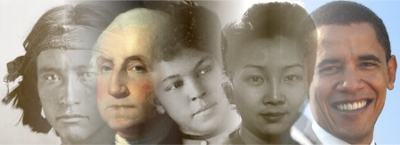Foreword to Examining the Evidence: Seven Strategies for Teaching with Primary Sources
Sam Wineburg,
Margaret Jacks Professor of Education and (by courtesy) of History
Director, Stanford History Education Group, author of Historical Thinking and Other Unnatural Acts
In August 2005, in the wake of Hurricane Katrina, two photos appeared on the Yahoo News website showing flood-ravaged citizens grasping food and drink as they navigated waters that poured into the streets of New Orleans. The caption accompanying one read: “two residents wade through chest-deep waters after finding bread and soda from a local grocery store.” The second photo depicted a similar scene. It showed a man wading through waters, also appearing to hold sodas under one arm and a garbage bag, presumably with food in it, in the other. But rather than “finding” such items, the man is described as having come by them after “looting” a store.
The photos are uncannily similar. Each depicts desperate people grasping items in the most dire of circumstances. Yet, in one case, the captions tell us, these people “found” these items; in the other, a man “looted” them. In one respect only are the photos markedly different. In one, the people are White; in the other, Black. I'll let you guess which caption accompanies which.1
Images and words. Neither is innocent. Both shape our thinking, urging us to believe one thing and not another, solidifying our stereotypes or, more rarely, confronting them. Like Katrina's waters, there's no escaping the flood of messages flowing into the nooks and crannies of our consciousness. They beckon to us from the laptop in our backpack, from the iPad on our nightstand, from the smartphone buzzing in our pocket. They call to us to buy something, to support something, to oppose something, to sign something, to tweet something, or to “Like” something. We are up to our neck in messages telling us what to do and think. Without the ability to interrogate these messages, we are destined to sleep walk through our world, blithely accepting without question that what makes one a “finder” or a “looter” is the color of one's skin. On one level, the book you are holding is about the reading of primary sources. But on a much deeper level, you are holding a manual for citizenship. This book is a guide for awakening tomorrow's citizens to the world they inhabit. Examining the Evidence rightfully dissolves the distinction between image and word in our digital society, where both can be twisted, retouched, ripped from one context and slotted into another, used to incite or quell depending on predetermined aims. This book's seven strategies sound an alarm that awakens us our digital world. How should we start? We begin by paying attention. Next, we ask questions.
Unlike other books that ostensibly promote the new Common Core State Standards, the questions of this book refuse pat answers. Looking at the iconic photograph of “migrant mother” (p. ___) , we ask about Dorothea Lange's motivations in serving a program that, according to fellow Farm Security Administration photographer Arthur Rothstein, sought “to document the problems of the Depression so that we could justify New Deal legislation that was designed to alleviate them.”2 But does knowing the motivation behind Lange's photo, does knowing that is one of a series of six, each one progressively zeroing in on the subject to achieve the right pose, diminish the emotion, the weather-beaten grief etched on Florence Thompson's face?3 Such questions thumb their nose in the face of easy answers. They give birth to even more questions.
The book you are holding demands that we learn to see differently, to weigh possibilities, to question more precisely, to argue for our interpretation, and justify our interpretation cogently and convincingly. Primary sources are means to a higher end -- one that applies not only to the social studies, but to every single subject in the curriculum. The book you are holding teaches students how to think.
Sam Wineburg
Margaret Jacks Professor of Education and History, Stanford University
Notes
1 Both pictures and captions are reproduced in Aaron Kinney, “Looting” or “Finding”? Salon , September 1, 2005, downloaded January 25, 2014, http://www.salon.com/2005/09/02/photo_controversy/
2 Arthur Rothstein, cited in James C. Curtis, “Making sense of documentary photography.” History Matters: The U.S. Survey on the Web , http://historymatters.gmu.edu/mse/photos Downloaded August 24, 2009.
3 On the other photos in Lange's series see, James C. Curtis, “Dorothea Lange, Migrant Mother, and the Culture of the Great Depression, Winterthur Portfolio , Vol. 21, No. 1 (Spring, 1986), pp. 1-20. For a strikingly different view of “migrant mother,” see the ever-provocative Erroll Morris, Believing is seeing: Observations on the mysteries of photography . New York: Penguin, 2011.
|

